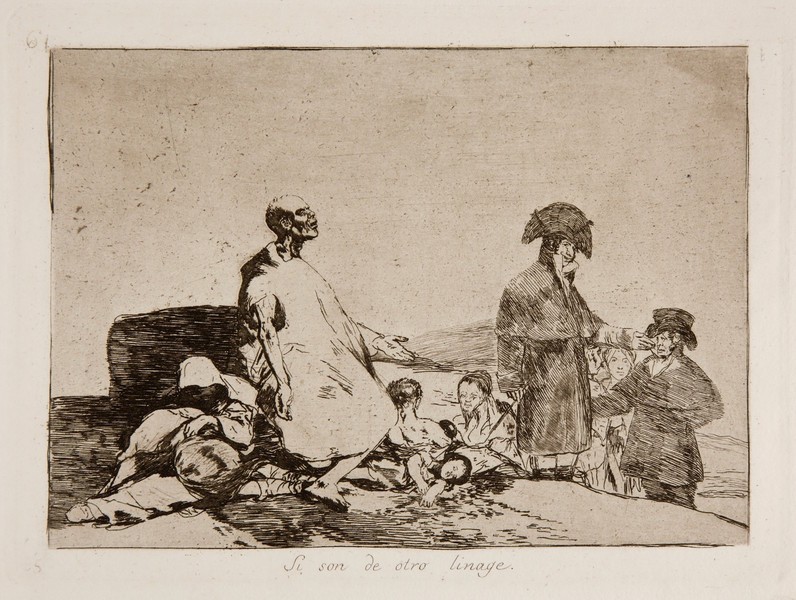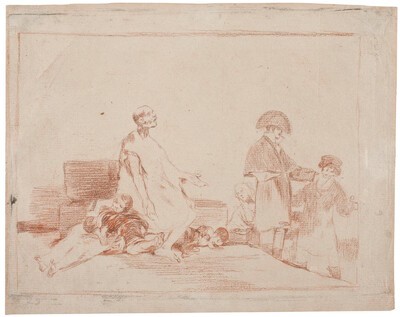- Cronología
- Ca. 1812 - 1815
- Dimensiones
- 156 x 208 mm
- Técnica y soporte
- Aguafuerte, lavis, punta seca, buril y bruñidor
- Reconocimiento de la autoría de Goya
- Undisputed work
- Ficha: realización/revisión
- 01 Dec 2010 / 31 May 2023
- Inventario
- 225
35 (on the lower left-hand corner).
See Sad presentiments of what must come to pass (Tristes presentimientos de lo que ha de acontecer).
The title was handwritten on the print by Goya in the first and only series that is known to have been printed at the time the works were created, which the artist gave to his friend Agustín Ceán Bermúdez. Therefore, the title was etched into the plate at a later date and left unchanged as of the first edition of the Disasters of War printed by the San Fernando Royal Academy of Fine Arts in Madrid in 1863, after the printing of the series in the possession of Ceán Bermúdez.
There is a surviving preparatory drawing for this print which is housed in the Prado Museum in Madrid.
A skeletal figure dressed in a white tunic stretches out his arms in a plea for help. He has an emaciated face, sunken eyes and prominent cheek and jawbones. The figure is surrounded by corpses and the dying, including women and children. Next to this group, some well-dressed, affluent figures ignore their pleas.
The clear sky, which in this case has not been rendered in aquatint, highlights the physical features of the figure begging for mercy. The artist accentuates the man's importance in the composition by dressing him in a white tunic. The clothing of the figures that witness the scene described as being "of another breed" in the title is rendered in aquatint, as are their indifferent faces.
The lack of food during times of war led to high levels of speculation, making fortunes for food producers who had, in the main, previously led a modest lifestyle. These nouveau riche changed their habits and dress, influenced by the arrival of new fashions from France. They would meet in the most prestigious, popular places in Madrid - such as Puerta del Sol, calle Carretas and calle Mayor - where there were also improvised morgues, and their prosperity marked a stark contrast with the poverty of the ordinary people.
Jesusa Vega establishes a connection between the second gentleman in the background and a drawing from Album E entitled Contemptuous of the insults (Despreciar los Ynsultos), which contains a self-portrait of the artist.
The plate is stored in the National Chalcography (cat. 312).
-
Goya. Das Zeitalter der Revolucionen. Kunst um 1800 (1980 – 1981)Hamburger KunsthalleHamburg1980cat. 92a
-
Goya y el espíritu de la IlustraciónMuseo Nacional del PradoMadrid1988from October 6th to December 18th 1988. Exhibited also at Museum of Fine Arts, Boston, January 18th to March 26th 1989; The Metropolitan Museum of Art, Nueva York, May 9th to July 16th 1989, Madrid curator Manuela B. Mena Marqués, scientific directors Alfonso E. Pérez Sánchez and Eleanor A. Sayrecat. 94
-
Francisco de GoyaMuseo d'Arte ModernaLugano1996exhibition celebrated from September 22nd to November 17th.cat. 61
-
Francisco de Goya: Maleri, Tegning, GrafikkNasjonalgallerietOslo1996from 10th to April 14th 1996cat. 46 y cat. 149
-
Francisco Goya. Sein leben im spiegel der graphik. Fuendetodos 1746-1828 Bordeaux. 1746-1996Galerie KornfeldBern1996from November 21st 1996 to January 1997cat. 145
-
Francisco Goya. Capricci, follie e disastri della guerraSan Donato Milanese2000Opere grafiche della Fondazione Antonio Mazzottacat. 141
-
Goya en tiempos de guerraMuseo Nacional del PradoMadrid2008consultant editor Manuela B. Mena Marqués, from April 14th to July 13th 2008cat. 106
-
Goya et la modernitéPinacothèque de ParisParís2013from October 11st 2013 to March 16th 2014cat. 100
-
Goya: Order and disorderMuseum of Fine ArtsBoston2014cat. 200
-
2022
-
Goya, grabadorMadridBlass S.A.1918cat. 163
-
Goya engravings and lithographs, vol. I y II.OxfordBruno Cassirer1964cat. 181
-
Vie et ouvre de Francisco de GoyaParísOffice du livre1970cat. 1096
-
Goya y el espíritu de la IlustraciónMadridMuseo del Prado1988pp. 316-317, cat. 94
-
Goya. Arte e condizione umanaNaplesLiguori editore1990lam. 194
-
Catálogo de las estampas de Goya en la Biblioteca NacionalMadridMinisterio de Educación y Cultura, Biblioteca Nacional1996cat. 275
-
El Libro de los Desastres de la GuerraMadridMuseo del Prado2000pp.115-117
-
ParísPinacoteca de París2013p. 150
-
Goya: Order & DisorderBostonMuseum of Fine Arts Boston Publications2014p. 293
-
Goya. In the Norton Simon MuseumPasadenaNorton Simon Museum2016pp. 114-151
-
Museo de Bellas Artes de Badajoz y Diputación de Badajoz2022p. 81

